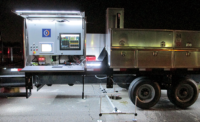
A bipartisan-sponsored piece of legislation that would increase the weight limits for trucks on the interstate highway system is in limbo for now, after the House Transportation and Infrastructure Committee voted 33-22 on Feb. 2 to delay consideration of any increase.
The legislation, however, has sparked debate about how to optimize infrastructure usage and balance wear and tear with more supply-chain efficiency.
Last year, Reps. Mike Michaud (D-Maine) and Jean Schmidt (R-Ohio) introduced H.R. 763, the Safe and Efficient Transportation Act of 2011, proposing that truck gross vehicle weight limits of 80,000 lb on most interstate highways with five axles be increased to 97,000 lb with an additional axle.
The bill, largely supported by big truckers, shippers and supply-chain users, would allow states to voluntarily authorize higher weight limits on roads and bridges. States would survey the infrastructure yearly and assess the potential increase in maintenance costs after five years.
The bill would call for a trust fund that collects additional fees—not to exceed $800 per vehicle a year—from truckers. The fund would be used to repair or replace any bridges proven to be negatively affected by the increased weight limits.
Such a bill could be a boon for infrastructure-assessment technology providers. Peter J. Vanderzee, president and chief executive officer of LifeSpan Technologies, proposed that sponsors add a "firewall" to the bill to ensure the money truckers pay into the trust fund would not be funneled elsewhere.
But the House voted down the bill— added as a provision to the House's proposed five-year, $260-billion transportation funding reauthorization—and called for a three-year period during which the U.S. Dept. of Transportation would study safety effects from a weight increase.
"The bill isn't dead, although it is on life support," Vanderzee says. "A lot of things are in flux" as the House and Senate continue to pursue their versions of transportation reauthorization legislation. In a letter to the House dated Jan. 30, Thomas Schatz, president of the Council for Citizens Against Government Waste, urged passage of the bill, citing a study by the American Transportation Research Institute that found a 97,000-lb truck is "17% more fuel-efficient on a tons-per- mile basis than a truck with a gross weight of 80,000 lbs."
Opponents argue the weight increase would damage an already fraying highway system. "Larger and heavier trucks also mean more wear and tear on our infrastructure," said Sen. Frank Lautenberg (D-N.J.) in a letter to the House. "This point is critical, considering the backlog on highway and bridge maintenance in the current budgetary climate."
Fears of Increased Costs
Unlike the big trucking firms, the Owner-Operator Independent Drivers Association also opposes the bill, fearing increased costs to its constituents. "This will lead to tax increases for all motorists as the amount of road and bridge damage from heavier trucks will far outstrip any user fee paid by the companies benefiting from the weight increase," the group stated in a release.
At the heart of the issue for engineers is the ability to "make more informed decisions about any potential unused capacity of our system," says Thomas Warne, a consultant and former president of the American Association of State Highway and Transportation Officials. "If we have capacity going unused because we just don't know about it and are being conservative, then that's capacity that should be opened up and made available."
Structural monitoring systems such as LifeSpan's and others could aid in identifying that capacity, he adds. "I could see that happening first on a trial basis—say, on one corridor," Warne says.
Lee Floyd, South Carolina Dept. of Transportation bridge maintenance engineer, says that sensors have saved thousands of dollars and helped avoid load restrictions on four of 10 bridges. "In the real world, bridges behave differently than on paper," he says. Nevertheless, "considering the overall state of our infrastructure, I can't understand why Congress would attempt to raise legal load limits."




Post a comment to this article
Report Abusive Comment